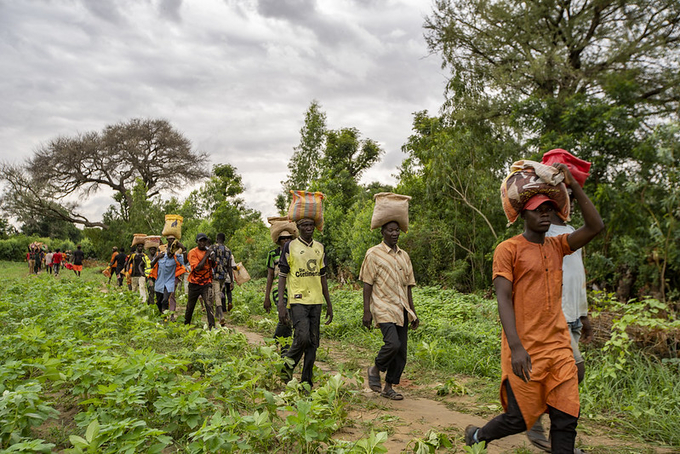May 22, 2025 | 10:09 GMT +7
May 22, 2025 | 10:09 GMT +7
Hotline: 0913.378.918
May 22, 2025 | 10:09 GMT +7
Hotline: 0913.378.918

Construction work underway on a flood protection dam in Niger.
The Food and Agriculture Organization of the United Nations (FAO) has called for immediate global action to address the impending impacts of La Niña. It follows one of the strongest 2023-2024 El Niño climate events on record that affected more than 60 million people worldwide, including severe droughts in Southern Africa.
FAO’s La Niña Anticipatory Action and Response Plan details essential anticipatory actions and early responses to act ahead of threats, safeguard the livelihoods of rural communities at high risk, and help vulnerable farming communities to mitigate negative effects on agriculture and food production.
Anticipated between September and November 2024 and expected to persist through January to March 2025, La Niña is expected to bring weather extremes with severe consequences for food security, particularly as around 282 million people already face acute food insecurity and urgently need assistance.
La Niña, a climate phenomenon characterized by the cooling of central and eastern Pacific waters, disrupts global weather patterns. It occurs every 2 to 7 years and lasts between 9 to 12 months. Climate change is driving an intensification in the frequency and impact of climate extremes such as those induced by El Niño and La Niña.
FAO’s Plan to protect the at-risk communities has a two-pronged approach – to act ahead of forecasted shocks to prevent their impacts and to deliver immediate assistance, where devastation from La Niña could not be avoided.
The Plan is proactive and risk-based, designed to ensure that vulnerable families receive support ahead of forecasted hazards, while simultaneously taking an adaptive approach to ensure that resources are re-allocated to where they are most needed, as conditions evolve.
It has three key objectives:
Protect people ahead of La Niña-induced disaster impacts through anticipatory actions, such as helping fishers protect their boats ahead of storms, reinforcing river embankments ahead of floods, distributing drought-tolerant seeds to small-scale farmers and protecting livestock health.
Capitalize on the positive spillover effects of La Niña and offset losses, for example by supplying seeds to flood-affected farmers so they can plant and regain a harvest as flood waters recede.
Deliver early response where La Niña causes devastation, including through prepositioning the most time-sensitive supplies such as veterinary medicines, seeds and water bladders, while providing cash to severely affected families to meet their most immediate needs.
FAO is urgently seeking donor support for its Plan and requires $ 318 million to provide critical support to 10.5 million people across 39 high-risk countries in Africa, Asia and Latin America.
Funds are needed most urgently to implement anticipatory actions, as triggers for these actions have already been reached in parts of the Greater Horn of Africa and Latin America.
According to FAO assessments, for every $1 invested in anticipatory action, there is a return for farming families of more than $7 in avoided losses and added benefits. With 282 million people already facing acute food insecurity globally, the stakes are high, and immediate action is required to prevent further deterioration of the situation.
As La Niña approaches, the expected impacts on global food security include altered rainfall patterns, with increased risks of heavy rains and flooding in some regions and drought in others. Countries in Southern Africa, East Africa, Latin America, and parts of Southeast Asia face significant threats to agricultural productivity and rural livelihoods.
Over 60 million people were affected globally by the 2023−2024 El Niño, which brought extreme weather events such as droughts, heatwaves and floods. Vulnerable regions like Southern Africa and the Horn of Africa were hit hardest, worsening food insecurity in areas already under strain.
FAO, in collaboration with governments and partners, responded to the El Niño crisis through anticipatory actions and emergency interventions in 24 at-risk countries in Asia, East and Southern Africa, Latin America and the Caribbean. The Organization supported 1.7 million vulnerable farmers, helping safeguard livelihoods and food security.
However, the upcoming La Niña event, anticipated between September and November 2024, poses new threats, including droughts, floods, and cyclones, which could further exacerbate food insecurity in already struggling regions.
(FAO)

(VAN) Attempts to bring down the price of the Japanese staple have had little effect amid a cost-of-living crisis.

(VAN) Fourth most important food crop in peril as Latin America and Caribbean suffer from slow-onset climate disaster.

(VAN) Shifting market dynamics and the noise around new legislation has propelled Trouw Nutrition’s research around early life nutrition in poultry. Today, it continues to be a key area of research.

(VAN) India is concerned about its food security and the livelihoods of its farmers if more US food imports are allowed.

(VAN) FAO's Director-General emphasises the need to work together to transform agrifood systems.

(VAN) Europe is facing its worst outbreak of foot-and-mouth since the start of the century.

(VAN) The central authorities, in early April, released a 10-year plan for rural vitalization.